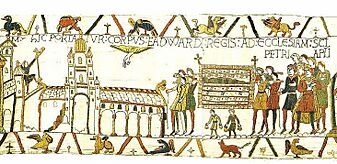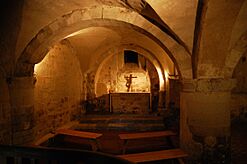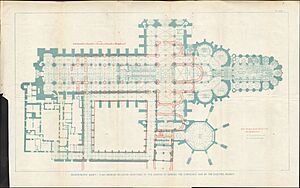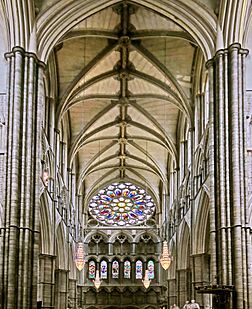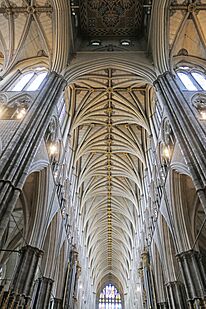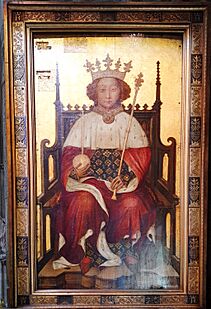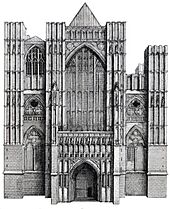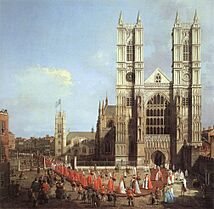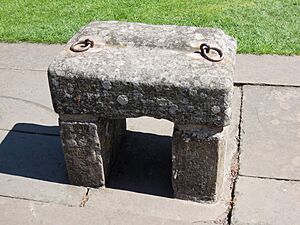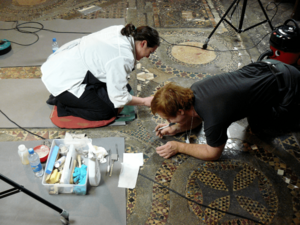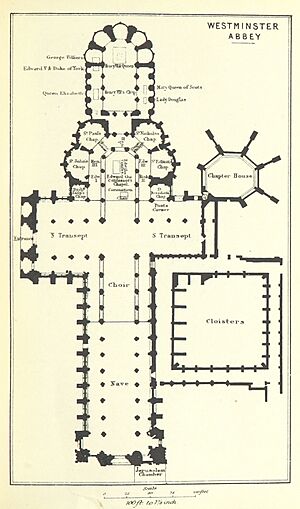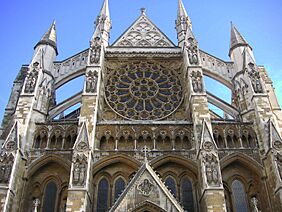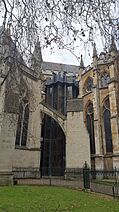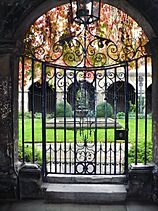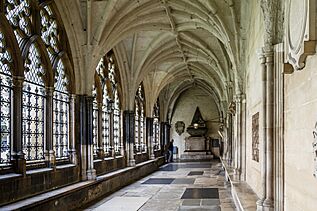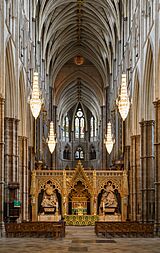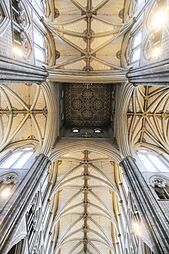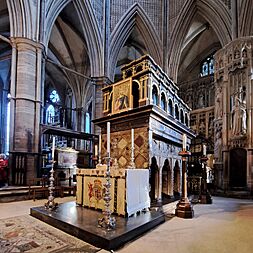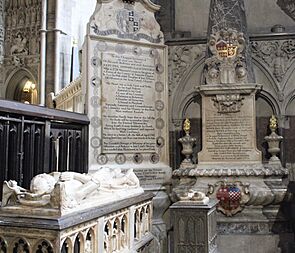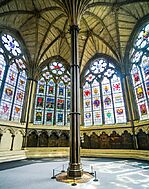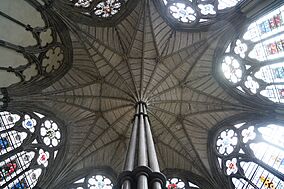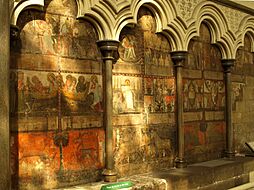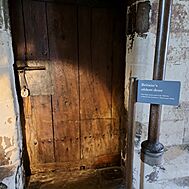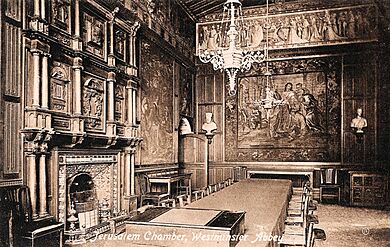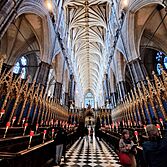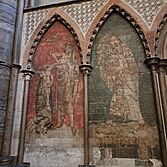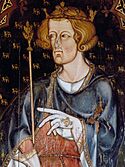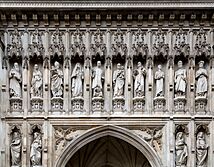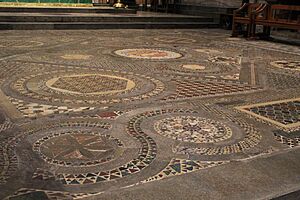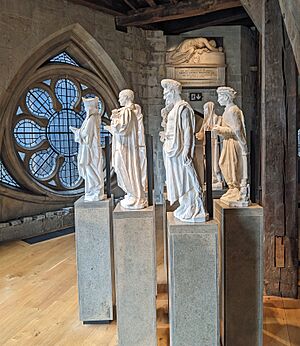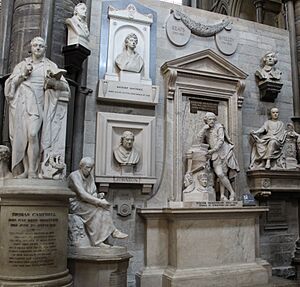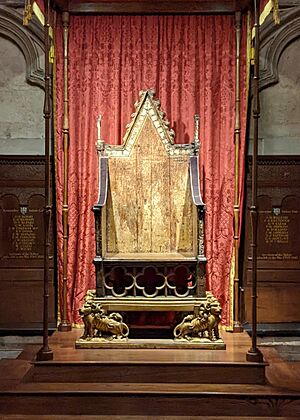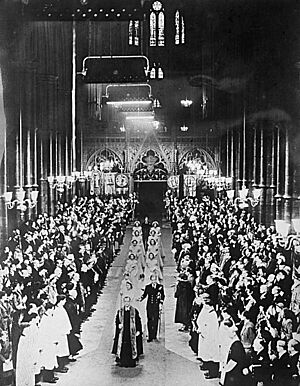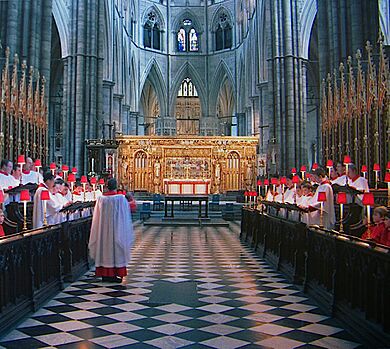Westminster Abbey facts for kids
Quick facts for kids Westminster Abbey |
|
|---|---|
| Collegiate Church of Saint Peter at Westminster | |
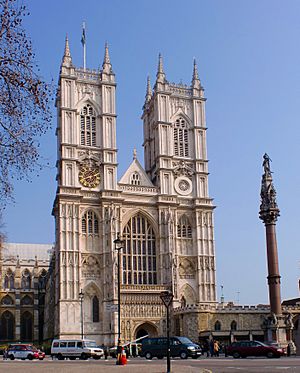
Westminster Abbey's western facade
|
|
| Lua error in Module:Location_map at line 420: attempt to index field 'wikibase' (a nil value). | |
| Location | Dean's Yard, London, SW1 |
| Country | England |
| Denomination | Church of England |
| Previous denomination | Catholic Church |
| Churchmanship | Liberal Catholic |
| History | |
| Status | Collegiate church |
| Founded | c. 959 |
| Consecrated | 28 December 1065, 13 October 1269 |
| Architecture | |
| Functional status | Active |
| Heritage designation | UNESCO World Heritage Site |
| Designated | 1987 |
| Specifications | |
| Nave width | 85 feet (26 m) |
| Height | 101 feet (31 m) |
| Floor area | 32,000 square feet (3,000 m2) |
| Number of towers | 2 |
| Tower height | 225 feet (69 m) |
| Materials | Reigate stone; Portland stone; Purbeck marble |
| Bells | 10 |
| Administration | |
| Diocese | Extra-diocesan (royal peculiar) |
Westminster Abbey, also known as the Collegiate Church of Saint Peter at Westminster, is a famous church in London, England. It has been the special place for crowning 40 English and British kings and queens since 1066. Many monarchs, including 18 kings and queens, are buried here. The Abbey has also hosted at least 16 royal weddings since the year 1100.
The Abbey started as a home for Benedictine monks around the mid-900s. King Edward the Confessor ordered the first large church building in the 1040s, and he is buried inside. The church you see today began being built in 1245 by King Henry III. In 1559, Queen Elizabeth I made the Abbey a "royal peculiar." This means it answers directly to the monarch, not to a bishop. In 1987, the Abbey, the Palace of Westminster, and St. Margaret's Church became a UNESCO World Heritage site. This was because of their important history and what they represent.
The church's Gothic architecture is mostly inspired by French and English styles from the 1200s. However, some parts have older Romanesque styles or newer Baroque and modern designs. The Henry VII Chapel, at the east end, is a great example of Perpendicular Gothic style. An old writer, John Leland, called it orbis miraculum, meaning "the wonder of the world."
Westminster Abbey is the burial place for over 3,300 people. Many of these are important figures in British history. They include kings, queens, prime ministers, poets, actors, scientists, and military leaders. The grave of the Unknown Warrior is also here. Because so many famous people are buried there, artist William Morris called the Abbey a "National Valhalla" (a hall for heroes).
Contents
History of Westminster Abbey
Historians agree that a monastery dedicated to Saint Peter existed on this site before the 1000s. Its exact beginning is not fully clear. One story says it was founded by a Saxon king named Sæberht of Essex. Another legend claims it was started by a fictional British king, Lucius, in the 2nd century. A tradition says a young fisherman on the River Thames saw Saint Peter nearby. This story is linked to why Thames fishermen used to offer salmon to the Abbey. The Fishmongers' Company still does this every year.
The Abbey's beginnings are generally thought to be around 959. At that time, Saint Dunstan and King Edgar brought a group of Benedictine monks to the site. This area was an island in the Thames called Thorn Ey. The original building is gone, but archaeologists have found pottery and foundations from that time.
Edward the Confessor's Church
Between 1042 and 1052, Edward the Confessor began rebuilding Saint Peter's Abbey. He wanted it to be a royal church where he could be buried. It was built in the Romanesque style. This was the first church in England built in a cruciform (cross-shaped) floorplan. The main stonemason was Leofsi Duddason. The building was finished around 1060 and opened on December 28, 1065. Edward died a week later, on January 5, 1066, and was buried in the church. Nine years later, his wife Edith was buried next to him.
Harold Godwinson, Edward's successor, was probably crowned here. However, the first coronation with clear records is that of William the Conqueror later that year.
The only picture we have of Edward's Abbey is in the Bayeux Tapestry. The foundations are still under the current church. Some lower parts of the monks' dormitory also survive. This includes a door said to be from the earlier Saxon Abbey. Edward's church was a bit smaller than the one today and had a central tower.
In 1103, Edward's tomb was opened. His body was found to be in perfect condition. This was seen as proof that he was a saint, and he was made a saint in 1161. Two years later, his body was moved to a new shrine. His ring was taken off and kept in the Abbey's collection.
The Abbey became more connected to royalty from the mid-1100s. Kings started using the nearby Palace of Westminster as their government center. In 1222, the Abbey was officially made free from the Bishop of London's control. This meant it answered only to the head of the Church. By this time, the Abbey owned a lot of land around it. This included areas from modern-day Oxford Street to the Thames. It also owned parishes in the City of London and several wharfs.
Outside London, the Abbey owned lands across southeast England. These were in Middlesex, Hertfordshire, Essex, Oxfordshire, and Gloucestershire. The abbot was also the lord of the manor in Westminster. A town of two to three thousand people grew around the Abbey. The Abbey was a big customer and employer, helping the town's economy. Relations with the town were usually friendly.
Henry III's Rebuilding Project
Westminster Abbey continued to be used for coronations. But after Edward the Confessor, no kings were buried there until Henry III. He began rebuilding it in the Gothic style. Henry III wanted it to be a special shrine for Edward. He also wanted it to be a burial place for himself and his family. Building started on July 6, 1245, led by Henry's master mason, Henry of Reynes. The first part built included the eastern end, the transepts, and the first part of the nave. The Lady chapel, built around 1220, was included in the new design.
Around 1253, John of Gloucester took over from Henry of Reynes. Then, Robert of Beverley replaced him around 1260. In the summer, up to 400 workers were on site. These included stonecutters, carpenters, painters, and more. From 1257, Henry III held meetings of local representatives in the Abbey's chapter house. These meetings were an early form of the House of Commons. Henry III also ordered the beautiful Cosmati pavement in front of the High Altar. More work added five more sections to the nave. Construction stopped around 1269. By 1261, Henry had spent a huge amount of money on the Abbey.
A special ceremony was held on October 13, 1269. During this, Edward the Confessor's remains were moved to their current shrine behind the main altar. After Henry's death and burial in the Abbey in 1272, building stopped. Edward the Confessor's old Romanesque nave stayed attached to the new building for over a hundred years.
In 1296, Edward I captured the Scottish coronation stone, the Stone of Scone. He had a special Coronation Chair made to hold it. He gave this chair to the abbot at Westminster Abbey. In 1303, the small crypt under the chapter house was broken into. A lot of the king's treasure was stolen. People thought the thieves must have had help from the Abbey monks. Fifty monks were then put in the Tower of London.
Finishing the Gothic Church
From 1376, Abbot Nicholas Litlyngton and Richard II gave a lot of money to finish the church. The rest of the old nave was taken down, and rebuilding began. His mason, Henry Yevele, followed the original design closely. This was even though it was over 100 years old. During the Peasants' Revolt of 1381, Richard prayed at Edward the Confessor's shrine for "divine aid" before meeting the rebels. Today, the Abbey displays Richard's full-length portrait. It is the earliest painting of an English king.
Building work was not fully finished for many years. Henry V was unhappy with the Abbey's unfinished state. He gave extra money for the rebuilding. In his will, he asked for a chantry chapel to be built over his tomb. You can still see this chapel from the ground. Between 1470 and 1471, Elizabeth Woodville, wife of Edward IV, found safety at Westminster Abbey. Her husband had been removed from power. She gave birth to Edward V in the abbot's house. In 1495, building finally reached the end of the nave, finishing with the west window.
Under Henry VII, the 13th-century Lady chapel was pulled down. It was rebuilt in a Perpendicular Gothic style. This is now known as the Henry VII Chapel. Work started in 1503, and the main structure was done by 1509. However, decorating continued for several more years. Henry's main reason for building such a grand chapel was to have a suitable burial place for another saint. He planned to have Henry VI made a saint. The Pope asked Henry VII for a lot of money for this. Henry VII did not want to pay, so he is buried in the center of the chapel with his wife, Elizabeth of York.
A picture of the Abbey from 1532 shows a lantern tower above the crossing. But this tower is not shown in any later pictures. It is likely it fell down or was never fully built. Other sources say a lantern tower was never completed. The current flat pyramid roof is from the 1700s. The painted wooden ceiling below it was put in after World War II bomb damage.
In the early 1500s, Abbot John Islip started a project. He wanted to add two towers to the western end of the church. These were partly built up to the roof level. Then, building stopped because of changes during the English Reformation.
Changes and Challenges
In the 1530s, Henry VIII separated from the Catholic Church in Rome. He took control of England's monasteries, including Westminster Abbey. This started the English Reformation. In 1535, the Abbey's yearly income was £3,000. Henry's agents removed many holy objects, statues, and treasures. The golden container for Edward the Confessor's coffin was melted down. Monks hid his bones to save them. The monastery was closed, and the building became a cathedral for a new Diocese of Westminster.
The Westminster diocese was closed in 1550. The Abbey was then seen as a second cathedral of the Diocese of London until 1556. Money meant for the Abbey, which is dedicated to Saint Peter, was sent to St. Paul's Cathedral. This led to the saying "robbing Peter to pay Paul".
The Abbey saw Benedictine monks return under the Catholic Mary I. But they were removed again under Elizabeth I in 1559. In 1560, Elizabeth made Westminster a "royal peculiar" again. This meant it was a Church of England church directly responsible to the queen. She made it the Collegiate Church of Saint Peter. This was a church without a bishop, but with a group of clergy called a chapter, led by a dean. From then on, it was simply a church, though still called an Abbey. Elizabeth also re-started Westminster School. She provided for 40 students, called the King's (or Queen's) Scholars. These scholars have a special duty: they shout Vivat Rex or Vivat Regina ("Long live the King/Queen") during a new monarch's coronation. Today, the dean of Westminster Abbey is still in charge of the school governors.
In the early 1600s, the Abbey hosted two groups of churchmen. They worked on the King James Version of the Bible. They met in the Jerusalem Chamber in the Abbey.
In 1642, the English Civil War began. The Dean and Chapter (Abbey leaders) left. Priests loyal to Parliament took their place. The Abbey itself was damaged during the war. Altars, stained glass, the organ, and the Crown Jewels were damaged or destroyed. Lord Protector Oliver Cromwell had a grand funeral there in 1658. But his body was dug up in January 1661. In 1669, the writer Samuel Pepys visited the Abbey. He saw the body of Queen Catherine of Valois from the 1400s. She had been buried in 1437. But her coffin was moved during building work and not reburied for 150 years. Pepys leaned in and kissed her, writing, "This was my birthday, thirty-six years old and I did first kiss a queen." She has since been reburied near her husband, Henry V. In 1685, a worker accidentally put a pole through Edward the Confessor's coffin. A choirboy found a cross on a chain inside. He gave it to King James II, who then gave it to the Pope. Its location is now unknown.
1700s and 1800s Changes
In the late 1600s, architect Christopher Wren became the Abbey's first Surveyor of the Fabric. He started a project to fix the outside of the church. His successor, William Dickinson, continued this work. After over 200 years, the Abbey's two western towers were finally built in the 1740s. Nicholas Hawksmoor and John James designed them in a mix of Gothic and Baroque styles.
On November 11, 1760, the funeral of George II was held at the Abbey. The king was buried next to his wife, Caroline of Ansbach. He asked for the sides of their coffins to be removed so their remains could mix. He was the last monarch buried in the Abbey. Around the same time, Richard II's tomb got a hole. Visitors could put their hands in. Several of his bones went missing. A boy from Westminster School took a jawbone. His family kept it until 1906, when it was returned to the Abbey.
In the 1830s, the screen between the nave and the choir was replaced. Edward Blore designed the new one. This screen holds monuments to scientist Isaac Newton and general James Stanhope. More restoration happened in the 1800s under architect George Gilbert Scott. He rebuilt parts of the chapter house and north porches. He also designed a new altar. His successor, J. L. Pearson, finished work on the north porches. He also rebuilt the northern rose window.
20th Century Events
The Abbey saw "Prayers For Prisoners" protests by suffragettes in 1913 and 1914. Protesters interrupted services by chanting and praying for suffragette prisoners. In one protest, a woman chained herself to her chair. On June 11, 1914, a bomb planted by suffragettes exploded inside the Abbey. No one was seriously hurt. But the bomb broke a corner of the Coronation Chair. It also caused the Stone of Scone to break in half. This was not found until 1950. That's when four Scottish nationalists broke in to steal the stone and take it back to Scotland.
For World War II bombing raids, the Coronation Chair and many Abbey records were moved out of London. The Stone of Scone was buried. In 1941, on the night of May 10–11, the Abbey was hit by bombs. Firefighters and the Abbey's own fire-watchers stopped the fire from spreading. But the deanery and three staff homes were badly damaged. The lantern tower above the crossing fell, leaving the Abbey open to the sky. The damage cost was about £135,000. Some damage can still be seen in the RAF Chapel. No one was killed, and services continued during the war. After the war, items were returned. A new permanent roof was built over the crossing.
Because of its great importance, the Abbey was named a UNESCO World Heritage Site in 1987. This included the nearby Palace of Westminster and St. Margaret's Church.
In 1997, the Abbey started charging visitors an entrance fee. It was getting about 1.75 million visitors each year.
21st Century Developments
In June 2009, the first major building work in 250 years was suggested. A "corona" (a crown-like feature) was proposed for the lantern over the central crossing. This was part of a larger £23-million project finished in 2013. On August 4, 2010, the Abbey decided not to build the corona.
The Cosmati pavement was cleaned and restored for two years, starting in 2008. On September 17, 2010, Pope Benedict XVI became the first pope to visit the Abbey. He took part in an evening prayer service. On April 29, 2011, the Abbey hosted the wedding of Prince William and Catherine Middleton.
In 2018, the Queen's Diamond Jubilee Galleries opened. These galleries are high up in the medieval triforium. They display the Abbey's treasures. A new Gothic access tower with a lift was designed by the Abbey architect, Ptolemy Dean.
In 2020, a 13th-century sacristy was found in the Abbey grounds. This was part of an archaeological dig. The sacristy was used by monks to store items for Mass, like vestments and chalices. Hundreds of buried bodies, mostly monks, were also found.
On March 10, 2021, a vaccination center opened in Poets' Corner. It gave out COVID-19 vaccines.
Architecture and Design
The Abbey is mostly built in a Geometric Gothic style. It uses Reigate stone for its outer layers. The church has an eleven-bay nave with aisles, transepts, and a chancel with an ambulatory and radiating chapels. The building is supported by two levels of flying buttresses. The western end of the nave and the west front were designed by Henry Yevele in a Perpendicular Gothic style. The Henry VII Chapel was built in a late Perpendicular style. The west towers were designed by Nicholas Hawksmoor. They mix the Gothic style of the Abbey with the Baroque style popular at the time.
Modern Westminster Abbey is largely based on French Gothic styles. It is especially like Reims Cathedral, not so much English Gothic styles of the same time. For example, English Gothic often has large, fancy towers. But Westminster Abbey did not have any towers until the 1700s. It is also more like French churches in its height-to-width ratio. Westminster Abbey has the highest nave of any Gothic church in England. Its nave is much narrower than other medieval English churches of similar height. Instead of a short, square eastern end (common in England), Westminster Abbey has a long, rounded apse. It also has chapels coming out from the ambulatory, which is typical of French Gothic style. However, there are also clear English parts. For example, it uses materials of different colors, like Purbeck marble and white stone in the crossing.
The northern entrance has three porches. The middle one has a beautifully carved tympanum. This led to its nickname "Solomon's porch," referring to the famous temple in Jerusalem.
The Abbey still has its 13th- and 14th-century cloisters. These would have been very busy when it was a monastery. The west cloister was used for teaching new monks. The north cloister was for private study. The south cloister led to the refectory (dining hall). The east cloister led to the chapter house and dormitory. In the southwest corner of the cloisters is a cellarium. Monks used it to store food and wine. Today, it is the Abbey café. The north cloister and northern end of the east cloister are the oldest, from around 1250. The rest are from 1352 to 1366. The Abbey also has a Little Cloister. It is where the monks' hospital used to be. The Little Cloister is from the late 1600s. It has a small garden with a fountain. A path from the Little Cloister leads to College Garden. This garden has been used for 900 years. It started as a medicine garden for the monks. Now, it is overlooked by clergy houses and the dormitory for Westminster School.
The newest part of the Abbey is the Weston Tower, finished in 2018. It was designed by Ptolemy Dean. It is between the chapter house and the Henry VII Chapel. It has a lift and spiral staircase. This allows people to reach the triforium, which holds the Queen's Diamond Jubilee Galleries. The tower has a star shape and leaded windows with a fancy crown roof. The lift shaft inside has 16 kinds of stone from the Abbey's history. The project took five years and cost £22.9 million.
Inside the Abbey
The church's inside has Purbeck marble pillars. The roof vaulting is very high, at 102 feet (31 m). It is one of Britain's highest church vaults. To fit many guests during coronations, the transepts were made extra long. The choir was placed east of the crossing, not west. This is also seen in Rheims Cathedral. The 13th-century inside would have been painted in bright colors and gold.
Even though the nave was built over centuries, builders stuck to the original design. So, it looks like one unified style. Small differences show the long break in building between 1269 and 1376. These can be seen at the fifth section from the crossing. The spandrels above the arches are decorated with patterns towards the older east end. They are plain towards the newer west end. Above the crossing, in the center, is a roof lantern. It was destroyed by a bomb in 1941 and fixed in 1958. In the choir aisles, shields of people who gave money for the 13th- and 14th-century rebuilding are carved and painted. At the eastern end of the nave is a large screen. It separates the nave from the choir. It is made of 13th-century stone, updated in 1834, and painted in the 1960s.
Behind the main altar is the shrine and tomb of Edward the Confessor. Holy shrines were once common in English churches. But most were destroyed during the English Reformation. Edward is the only major English saint whose body is still in his shrine. Around him, in a horseshoe shape, are tombs of medieval kings and queens. These include Henry III, Eleanor of Castile, Edward I, Philippa of Hainault, Edward III, Anne of Bohemia, and Richard II. Henry V is in the center, at the eastern end. Henry III's tomb was once covered with colored glass and stone. Tourists have picked these off over time. Above Henry V's tomb is a chantry chapel. It has many sculpted figures, including Henry V riding a horse. The shrine is closed to the public, except for special events.
The Abbey has side chapels that branch off from the main path. Many were originally altars for individual saints. Many still have saints' names, like St. Nicholas and St. Paul. After the English Reformation, these chapels were used for extra burials and monuments. In the north are the Islip Chapel, the Nurses' Memorial Chapel, the Chapel of Our Lady of the Pew, the Chapel of St. John the Baptist, and St. Paul's Chapel. The Islip Chapel is named after Abbot John Islip. Its screen has a visual pun on his name: an eye and a boy falling from a tree (eye-slip). Other chapels in the north transept are named after St. John the Evangelist, St. Michael, and St. Andrew. The chapels of St. Nicholas, St. Edmund, and St. Benedict are in the south.
The south transept is smaller than the northern one. This is because the 13th-century builders built against the older 11th-century cloisters. To make the transepts match, the south transept hangs over the western cloister. This allowed for a room above the cloisters. It was used to store the Abbey's important papers. In the south transept is the chapel of St. Faith. It was built around 1250 as the vestry for the monks. On the east wall is a painting from around 1290–1310 of St. Faith. She is holding the grid-iron on which she was roasted to death.
Chapter House and Pyx Chamber
The eight-sided chapter house was used by the Abbey monks for daily meetings. They would hear a part of the Rule of St. Benedict and get their instructions from the abbot. The chapter house was built between 1250 and 1259. It is one of the largest in Britain, almost 60 feet (18 m) across. For 300 years after the English Reformation, it stored state records. These were moved in 1863. George Gilbert Scott restored it in the 1800s.
The entrance is from the east cloister through two hallways. The ceiling gets higher as you approach the chapter house. It is an octagonal room with a central pillar and a small crypt below. Around the sides are benches for 80 monks. Above these are large stained-glass windows. They show the coats of arms of monarchs and Abbey leaders. The outside has flying buttresses (added in the 1300s) and a lead roof. The inside walls have 14th- and 15th-century paintings. These show the Apocalypse, the Last Judgement, and animals. The chapter house also has an original, mid-13th-century tiled floor. A wooden door in the hallway, made from a tree cut down between 1032 and 1064, is one of Britain's oldest. It might have been the door to the 11th-century chapter house.
The nearby Pyx Chamber was the basement of the monks' dormitory. It dates to the late 1000s. It was used as a treasury for the monks and the king. The outer walls and round pillars are also from the 1000s. Some pillar tops were decorated in the 1100s. A stone altar was added in the 1200s. The word pyx refers to a box where coins were kept. These coins were shown to a jury during the Trial of the Pyx. This was to make sure new coins met the right standards. The chapter house and Pyx Chamber are looked after by English Heritage.
Henry VII Chapel
The Henry VII Lady Chapel is a large chapel at the far eastern end of the Abbey. King Henry VII paid for it in his will. The chapel, built in a late Perpendicular Gothic style, was called the orbis miraculum (wonder of the world) by poet John Leland. The tombs of several monarchs are in this chapel. These include Edward V, Henry VII, Edward VI, Mary I, Elizabeth I, James I, Charles II, George II, and Mary, Queen of Scots.
It is famous for its unique ceiling, with pendant- and fan vault-style designs. Writer Washington Irving said it was "achieved with the wonderful minuteness and airy security of a cobweb." The ceiling is not a true fan vault, but looks like one. The inside walls are richly decorated with carvings, including 95 statues of saints. Many saint statues in England were destroyed in the 1600s, so these are rare. They would have originally been painted and gilded. From outside, the chapel walls are supported by flying buttresses. Each is a tower with a dome. In the center of the chapel is the tomb of Henry VII and his wife, Elizabeth of York. It was sculpted by Pietro Torrigiano.
The chapel has smaller chapels branching off. One, to the north, holds the tombs of Mary I and Elizabeth I. Both coffins are in Elizabeth's monument. Another, to the south, holds the tomb of Mary, Queen of Scots. Both monuments were ordered by James I, who was Elizabeth's successor and Mary's son. At the far eastern end is the RAF Chapel. It has a stained-glass window for those who died in the 1940 Battle of Britain. The RAF Chapel was the original burial place of Oliver Cromwell in 1658.
The chapel has been the main church for the Order of the Bath since 1725. The banners of its members hang above the stalls. The stalls still have their medieval misericords. These are small ledges for monks to rest on during services. They often have funny carvings.
Monastic Buildings
Many rooms used by the monks have been given new purposes. The dormitory became a library and a school room. The monks' offices are now houses for the clergy. The abbot had his own living area and ate separately from the other monks. These lodgings, now used by the Dean of Westminster, are probably the oldest continuously lived-in homes in London. They include the Jericho Parlour and the Jerusalem Chamber (built in 1369). There is also a grand dining hall with a minstrels' gallery, now used by Westminster School. The prior also had his own home, separate from the monks. This was on the site of today's Ashburnham House, now part of Westminster School.
Artworks and Special Items
The nave and transepts have sixteen crystal chandeliers. They are made of hand-blown Waterford glass. These were given by the Guinness family in 1965. They celebrated the Abbey's 900th anniversary. The choir stalls were designed by Edward Blore in 1848. Some stalls are for high commissioners from Commonwealth of Nations countries.
Beyond the crossing to the west is the sacrarium, which holds the high altar. The Abbey has the 13th-century Westminster Retable. This is thought to be the altarpiece from Henry III's 13th-century church. It is the earliest surviving English panel painting altarpiece. The current high altar and screen were designed by George Gilbert Scott between 1867 and 1873. They have sculptures of Moses, St. Peter, St. Paul, and King David. There is also a mosaic of the Last Supper.
The south transept has wall paintings from around 1300. These are called "the grandest of their time remaining in England." They show Thomas the Apostle looking at Christ's wounds and St. Christopher carrying the Christ Child. The paintings were found in 1934 behind two monuments. Fourteenth-century paintings are on the backs of the sedilia (seats for priests). On the south side are three figures: Edward the Confessor, the angel Gabriel, and the Virgin Mary. On the north side are two kings (possibly Henry III and Edward I) around a religious figure, possibly St. Peter. They were hidden during the Commonwealth period and later rediscovered.
Over the Great West Door are ten statues of 20th-century Christian martyrs. They are from different Christian groups. The Abbey's craftsmen sculpted them in 1998. Those remembered include Maximilian Kolbe, Manche Masemola, Janani Luwum, Grand Duchess Elizabeth Feodorovna, Martin Luther King Jr., Óscar Romero, Dietrich Bonhoeffer, Esther John, Lucian Tapiedi, and Wang Zhiming.
From the chapter house, a door leads to the Abbey's library. This was once a dormitory for the monks. It has been used as a library since the 1500s. The collection has about 16,000 books. Next to the library is the Muniment Room. This is where the Abbey's historical records are kept.
The Cosmati Pavement
At the crossing, in front of Edward the Confessor's shrine and the main altar, is the Cosmati pavement. This is a 700-year-old tile floor. It is made of almost 30,000 pieces of colored glass and stone. It measures almost 25 feet square. Coronations take place here.
The floor is named after the Cosmati family in Rome. They were known for this type of work. Richard Ware ordered it. He traveled to Rome in 1258 when he became abbot. He returned with stone and artists. The porphyry stone came from as far away as Egypt. It was likely brought to Italy during the Roman Empire. The pavement had a Latin message in brass letters (now gone). It named the artist as Odericus. This probably meant Pietro di Oderisio or his son. The message also predicted the end of the world 19,863 years after it was made. Unlike normal mosaic work, the pieces were not cut to a uniform size. They used a technique called opus sectile ("cut work"). It is special among Cosmati floors in Europe. It uses dark Purbeck-marble borders instead of the usual white marble. The pavement influenced later floors at St George's Chapel, Windsor Castle, and Canterbury Cathedral.
Geometric designs, like those in the pavement, were thought to help the monks think deeply. They showed medieval Christian ideas about the universe that were hard to put into words. Much of the design uses the geometric doubling of the square. This was a secret among stonemasons. The four-sided squares, four-fold symmetry, and four inner roundels represent the four elements of classical philosophy. The central roundel represents the universe before it was formed. Each inner roundel is touched by two bands. These show shared qualities of each element. For example, water and air were both seen as "moist."
Stained Glass Windows

The Abbey's 13th-century windows would have been filled with stained glass. But much of this was destroyed in the English Civil War and the Blitz. It was replaced with clear glass. Since the 1800s, new stained glass has been added. Artists like Ninian Comper and Hugh Easton designed these.
The north rose window was designed by James Thornhill in 1722. It shows Christ, the apostles, the Four Evangelists, and the Bible in the center. The window was restored in the 1800s. Thornhill also designed the great west window. It shows Biblical figures like Abraham, Isaac, and Jacob.
In the Henry VII Chapel, the west window was unveiled in 1995. It shows coats of arms of the Abbey's supporters. The central east window, unveiled in 2000, shows Comet Hale–Bopp as the star of Bethlehem.
In 2018, artist David Hockney unveiled a new stained-glass window. It celebrates Queen Elizabeth II. It shows a country scene inspired by his home in Yorkshire. Hockney designed the window using an iPad.
Queen's Diamond Jubilee Galleries
The Westminster Abbey Museum used to be in the 11th-century vaulted basement. This is one of the oldest parts of the Abbey. It was a museum since 1908. But it closed in June 2018. It was replaced by the Queen's Diamond Jubilee Galleries. These are high up in the Abbey's triforium. You reach them through the Weston Tower, which has a lift and stairs.
The exhibits include life-size effigies of English and British monarchs. These were originally made for funeral processions or to be displayed over tombs. The effigies are from the 1300s to the 1700s. Some still have their original clothes.
Also on display is The Coronation Theatre, Westminster Abbey: A Portrait of Her Majesty Queen Elizabeth II. This is a painting of Queen Elizabeth II standing on the Cosmati pavement where she was crowned in 1953. Other exhibits include a model of a tower designed by Christopher Wren that was never built. There is also a paper model of the Abbey for Queen Victoria's 1837 coronation. You can also see the wedding license of Prince William and Catherine Middleton. They were married in the Abbey in 2011.
Burials and Memorials
Over 3,300 people are buried or remembered in the Abbey. For much of its history, most people buried there (besides monarchs) were connected to the church. These were ordinary locals or monks. Since the 1700s, it has been a great honor for any British person to be buried or remembered in the Abbey. This became even more popular after the grand funeral of Isaac Newton in 1727. By 1900, so many important people were buried there that writer William Morris called it a "National Valhalla."
Politicians buried in the Abbey include Pitt the Elder and Pitt the Younger. A group of scientists are buried near Isaac Newton's tomb, including Charles Darwin and Stephen Hawking. Actors like David Garrick and Laurence Olivier are also here. Musicians are often buried in the north aisle of the nave, such as Henry Purcell and Ralph Vaughan Williams. George Frideric Handel is buried in Poets' Corner.
About 18 English, Scottish, and British monarchs are buried in the Abbey. These include Edward the Confessor, Henry III, Edward I, Edward III, Richard II, Henry V, Edward V, Henry VII, Edward VI, Mary I, Mary Queen of Scots, Elizabeth I, James I, Charles II, Mary II, William III, Queen Anne, and George II. Elizabeth and Mary Queen of Scots were the last monarchs to have full tomb statues. Monarchs buried after them are remembered with simple inscriptions. George II was the last monarch buried in the Abbey, in 1760. George III's brother, Henry Frederick, was the last royal family member buried there, in 1790. Most monarchs after George II have been buried at St. George's Chapel, Windsor, or at the Frogmore Royal Burial Ground.
Poets' Corner
The south transept of the church is called Poets' Corner. This is because many poets and writers are buried or remembered there. The first was Geoffrey Chaucer (buried around 1400). He worked for the king and had rooms in the Abbey. Another poet, Edmund Spenser, was buried nearby in 1599. The idea of a Poets' Corner became popular in the 1700s. Memorials were put up for writers buried elsewhere, like William Shakespeare and John Milton. Since then, writers buried in Poets' Corner include John Dryden, Alfred, Lord Tennyson, Charles Dickens, and Rudyard Kipling. Not all writers buried in the Abbey are in Poets' Corner. Ben Jonson is buried standing upright in the north aisle of the nave.
The Unknown Warrior
On the floor, just inside the Great West Door, is the grave of the Unknown Warrior. This is an unidentified soldier killed in Europe during the First World War. Many countries have a Tomb of the Unknown Soldier. But the one in Westminster Abbey was the first. The idea came from army chaplain David Railton in 1920. The funeral was held on November 11, 1920. This was the second anniversary of the war's end. The Unknown Warrior lay in state for a week. About 1.25 million people visited his grave during that time. This grave is the only floor stone in the Abbey where walking is forbidden. Every visit by a foreign head of state starts here.
Royal Occasions
The Abbey has strong ties to the royal family. Monarchs have supported it. It has been the place for coronations, royal weddings, and funerals. Several monarchs have attended services there. One monarch was born and one died at Westminster Abbey. In 1413, Henry IV collapsed while praying at Edward the Confessor's shrine. He was moved to the Jerusalem Chamber and died soon after. Edward V was born in the abbot's house in 1470.

The first jubilee celebration at the Abbey was for Queen Victoria's Golden Jubilee in 1887. She wore her black mourning clothes instead of her full coronation robes. She sat in the Coronation Chair. Queen Elizabeth II and Prince Philip marked their silver, gold, and diamond wedding anniversaries with services at the Abbey. They also regularly attended Commonwealth Day events there.
The monarch takes part in the Royal Maundy service each Maundy Thursday. During this, elderly people receive special coins. The service has been held at churches around the country since 1952. It returns to the Abbey every 10 years.
Coronations at the Abbey

Since the coronation of William the Conqueror in 1066, 40 English and British monarchs have been crowned in Westminster Abbey. This does not include Edward V, Lady Jane Grey, and Edward VIII, who were never crowned. In 1216, Henry III could not be crowned in the Abbey. London was held by enemy forces. Henry was crowned in Gloucester Cathedral. He had a second coronation at Westminster Abbey in 1220. When he had the Abbey rebuilt, it was designed with long transepts. This was to fit many guests at future coronations. Much of the service order comes from the Liber Regalis. This is a special book made in 1377 for Richard II's coronation. It is kept in the Abbey's collections. On May 6, 2023, the coronation of Charles III took place at the Abbey. The area used is the crossing, called "the theatre" because it's good for grand events. This space is open, not filled with fixed seats. This allows for temporary seating in the transepts.
The Coronation Chair is the throne where English and British rulers sit when crowned. It is in the Abbey's St. George's Chapel near the west door. It has been used for coronations since the 1300s. From 1301 to 1996, the chair held the Stone of Scone. This is the stone where the kings of Scots were crowned. (It was briefly stolen in 1950 by Scottish nationalists.) Although it is now kept in Scotland, the stone is returned to the Coronation Chair for coronations. The chair was open to the public in the 1700s and 1800s. People could sit in it, and some carved their initials into the wood.
Before the 1600s, a king would have a separate coronation for his new queen if he married after his own coronation. The last of these in the Abbey was for Anne Boleyn in 1533. Fifteen coronations of queens consort have been held in the Abbey.
Henry II held a coronation ceremony at Westminster Abbey in 1170 for his son. This son was known as Henry the Young King. Henry II did this while he was still alive to make sure his son would take the throne. However, the Young King died before his father and never became king.
Royal Weddings at the Abbey
At least 16 royal weddings have happened at the Abbey. Royal weddings here were rare before the 1900s. Royals often married in a Chapel Royal or at Windsor Castle. This changed with the 1922 wedding of Princess Mary at the Abbey. In 1923, Lady Elizabeth Bowes-Lyon was the first royal bride to leave her bouquet on the grave of the Unknown Warrior. Many royal brides have continued this tradition.
Royal weddings have included:
| Year | Groom | Bride |
|---|---|---|
| 1100 | Henry I of England | Matilda of Scotland |
| 1243 | Richard, Earl of Cornwall | Sanchia of Provence |
| 1269 | Edmund, Earl of Leicester and Lancaster | Aveline de Forz |
| 1382 | Richard II of England | Anne of Bohemia |
| 1486 | Henry VII of England | Elizabeth of York |
| 1919 | Captain The Hon. Alexander Ramsay | Princess Patricia of Connaught |
| 1922 | Henry Lascelles, Viscount Lascelles | The Princess Mary |
| 1923 | Prince Albert, Duke of York | Lady Elizabeth Bowes-Lyon |
| 1934 | Prince George, Duke of Kent | Princess Marina of Greece and Denmark |
| 1947 | Lieutenant Philip Mountbatten | The Princess Elizabeth |
| 1960 | Antony Armstrong-Jones | The Princess Margaret |
| 1963 | The Hon. Angus Ogilvy | Princess Alexandra of Kent |
| 1973 | Captain Mark Phillips | The Princess Anne |
| 1986 | The Prince Andrew | Sarah Ferguson |
| 2011 | Prince William of Wales | Catherine Middleton |
Royal Funerals at the Abbey
Many royal funerals took place at the Abbey between Edward the Confessor's in 1066 and Prince Henry's in 1790. There were no royal funerals at the Abbey from then until Queen Alexandra's in 1925. She was buried at Windsor Castle. Other queens, like Mary of Teck in 1953 and Queen Elizabeth The Queen Mother in 2002, also had funerals at the Abbey before being buried elsewhere.
On September 6, 1997, the funeral of Diana, Princess of Wales was held at the Abbey. Before the funeral, the Abbey's railings were covered with flowers and tributes. This event was seen by more people than any other in the Abbey's history. Two billion television viewers watched worldwide. Diana was buried privately on an island at Althorp, her family estate.
On September 19, 2022, the state funeral of Elizabeth II took place at the Abbey. This was before her burial at St George's Chapel, Windsor. It was the first funeral of a monarch at Westminster Abbey in over 260 years.
People of the Abbey
Dean and Chapter
Westminster Abbey is a collegiate church. It is run by the Dean and Chapter of Westminster. This was set up by a royal charter from Elizabeth I in 1560. It made it the Collegiate Church of St. Peter Westminster, a royal peculiar. In 2019, David Hoyle became the Dean of Westminster. The chapter has four canons and a senior manager. One of the canons is also the rector of the nearby St Margaret's Church, Westminster. They are often the chaplain for the Speaker of the House of Commons. Besides the dean and canons, there are also minor canons.
King's Almsmen and Almswomen
Six King's (or Queen's) almsmen and women are supported by the Abbey. The monarch appoints them based on the dean's advice. They attend Sunday services and do small duties for a small payment. When on duty, they wear a special red gown with a crowned rose badge.
The almshouse was started near the Abbey by Henry VII in 1502. The twelve almsmen and three almswomen were originally minor court officials. They retired due to age or disability. They had to be over 50, single, with a good reputation, able to read, and able to care for themselves. The building was torn down in 1779 for road widening. From the late 1700s to the late 1900s, almsmen were usually old soldiers and sailors. Today, they are mostly retired Abbey employees.
Schools at the Abbey
Westminster School is located in the Abbey. Teaching has happened there since the 1300s with the Abbey's monks. The school sees Elizabeth I as its founder. She closed the monastery for the last time and set up the school. The schoolboys were sometimes rowdy. Westminster boys have damaged the Coronation Chair. They have also interrupted services. One schoolboy carved on the Coronation Chair that he slept in it overnight. Westminster School became separate from the Abbey in 1868. But the two institutions are still closely connected. Westminster Abbey Choir School is also on the Abbey grounds. It educates the choirboys who sing for Abbey services.
Order of the Bath
The Most Honourable Order of the Bath is a British order of chivalry. Its spiritual home is the Abbey's Henry VII Chapel. George I founded the order in 1725. It became less popular after 1812. George V brought it back in 1913. The name comes from an old ceremony for making a knight. This included bathing as a symbol of being clean. Members get stalls with their banner and crest at ceremonies every four years. Since there are more members than stalls, some wait many years for their ceremony. The Order of the Bath is the fourth-oldest British order of chivalry.
Music at the Abbey
Andrew Nethsingha has been the Abbey's organist and master of the choristers since 2023. Peter Holder is the sub-organist. Matthew Jorysz is the assistant organist. Dewi Rees is the organ scholar.
The Choir
Since it started in the 1300s, the main job of the Westminster Abbey choir has been to sing for daily services. The choir also plays a key role in many state events. These include royal weddings and funerals, coronations, and memorial services. In 2012, the choir was invited by Pope Benedict XVI to sing with the Sistine Chapel Choir. This was at a Papal Mass in St. Peter's Basilica. The all-male choir has twelve professional adult singers. It also has thirty boy choristers aged eight to 13. These boys attend the Westminster Abbey Choir School.
The Organ
The first mention of an organ at Westminster Abbey was in 1240. Henry III gave money for its repair. An inventory in 1540 listed organs in the choir and Islip Chapel. During the Commonwealth, a source said soldiers "brake downe the Organ." But an organ was played in 1660, suggesting it wasn't fully destroyed. In 1720, an organ given by George II was installed. It was rebuilt in 1848.
A new organ was built in 1937. It has four manuals and 84 speaking stops. It was first played publicly at the coronation of George VI and Elizabeth that year. Some pipes from the old organ were used in the new one. The two organ cases were put back and colored in 1959.
In 1982 and 1987, the organ was made bigger. It now has five manuals and 109 speaking stops. Its control panel was updated in 2006. The Abbey has three other organs: the Queen's Organ, a smaller continuo organ, and a practice organ.
The Bells
There have been bells at the Abbey since at least Henry III's time. The current bells were put in the north-west tower in 1971. There are ten bells for change ringing. They were made in 1971. The largest bell weighs over 3,400 pounds (1,544 kg). Two other service bells were made in 1585 and 1598. A sanctus bell was made in 1738. Two bells are not used. The Westminster Abbey Company of Ringers rings the bells for special events. This includes the wedding of Prince William and Catherine Middleton.
Westminster Abbey in Popular Culture

Westminster Abbey is mentioned in the play Henry VIII by William Shakespeare. A gentleman describes Anne Boleyn's coronation in the play. The Abbey was also mentioned in a 1598 sonnet by Thomas Bastard. Poetry about the Abbey has also been written by Francis Beaumont and John Betjeman. The building has appeared in paintings by artists like Canaletto and J. M. W. Turner.
Playwright Alan Bennett made The Abbey, a 1995 documentary. It tells about his experiences in the building. Key scenes in the book and film The Da Vinci Code happen in Westminster Abbey. The Abbey did not allow filming in 2005. They called the book "theologically unsound." So, the film used Lincoln Cathedral instead. The Abbey gave its staff a fact sheet. It answered questions and corrected claims made in the book. In 2022, it was announced that the Abbey gave rare permission to film inside for the untitled eighth Mission: Impossible film.
See also
 In Spanish: Abadía de Westminster para niños
In Spanish: Abadía de Westminster para niños


